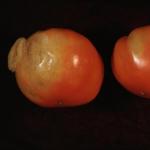Tomato, Physiological Ripening Disorders
Several ripening disorders can affect both greenhouse and field tomatoes, including blotchy ripening, yellow shoulder, and gray wall. These physiological disorders occur most often in greenhouses or high tunnels but can also occur in field tomatoes. Damage to fruit may be significant, reducing marketable yield.
Identification
Blotchy ripening, yellow shoulder, gray wall, and internal whitening all produce similar symptoms in tomato fruit, and may in fact be different symptoms of the same disorder. All four disorders result in uneven ripening of tomato fruit. ‘Blotchy ripening’ usually refers to the disorder when parts of the fruit surface remain green, yellow, or orange and do not ripen. ‘Yellow shoulder’ is the term used when the discoloration occurs on the “shoulders” of the fruit, surrounding the stem. ‘Gray wall’ is the term used when the outer fruit walls turn brown or gray and collapse, compared to ‘internal whitening’, which refers to when the outer and inner fruit walls become white and corky.
Varieties that have green shoulders in immature fruit are more likely to show the disorder. If you aren’t sure whether a variety has the gene for green shoulders, check with the seed supplier, or review the tomato cultivar descriptions available from the North Carolina State University site.
Cause
Severe cases of blotchy ripening and yellow shoulder are most often associated with factors that limit the supply of potassium to maturing fruit. These factors include: waterlogged and/or compacted soils, below-optimal potassium application rates, above-optimal nitrogen application rates, excessive application of potassium competitors, excessively large or dense canopies, and environmental conditions described in the next section. Inadequate potassium is linked to this disorder. Research in processing tomatoes has shown that adequate potassium early in tomato plant development is necessary. Soil conditions that influence potassium availability, such as levels of magnesium and calcium are also a factor.
Yellow shoulders are often found on tomato fruit exposed directly to the sun. On plants pruned to a single stem there may be many fruit in this situation. Loss of foliage due to disease can also expose fruit to the sun. If tomato fruit gets extremely hot it may exhibit sunscald, with the skin and flesh turning white and sunken on the exposed area of the fruit. Covering a high tunnel with shade cloth can reduce temperature in the tunnel.
Ripening disorders are most prevalent when air temperatures during mid-late stages of fruit ripening are extreme (e.g., below 60°F and/or above 90°F) or highly variable, when humidity levels remain high, and/or when these conditions prevail and light levels are low. Unfortunately, these are not uncommon conditions in New England and are largely out of our control. Tomato mosaic virus can cause similar symptoms of uneven fruit ripening and should be ruled out as the underlying cause.
Cultural Controls & Prevention
Cultivars vary in susceptibility to this disorder, so choose varieties that do not commonly exhibit blotchy ripening. Importantly, avoid low or excessively high greenhouse temperatures (below 60°F and/or above 90°F). Furthermore, greenhouses and high tunnels should be ventilated to maintain humidity at or below the ambient humidity outdoors. Plant nutrient and water status also influence the occurrence of blotchy ripening, so growers should provide balanced fertilization and regular watering. Plant canopies should be managed to allow for air circulation while maintaining adequate fruit cover.
Crops Affected by this Disorder
Tomato, Field
Tomato, Greenhouse
--revised by G. Higgins & S. Scheufele, January 2019
The Center for Agriculture, Food and the Environment and UMass Extension are equal opportunity providers and employers, United States Department of Agriculture cooperating. Contact your local Extension office for information on disability accommodations. Contact the State Center Director’s Office if you have concerns related to discrimination, 413-545-4800 or see ag.umass.edu/civil-rights-information.



